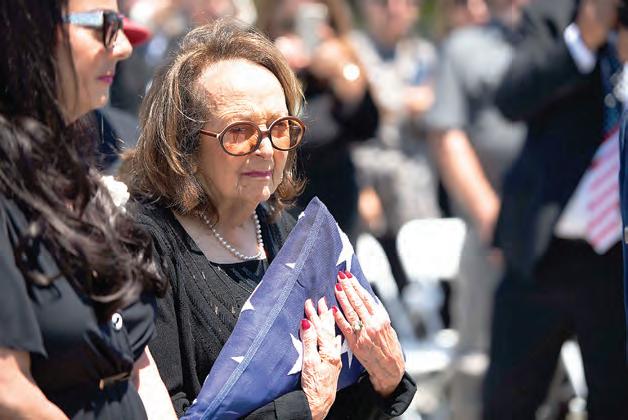
3 minute read
Travis honors 100 years of aerial refueling
Chustine Minoda 60TH AIR MOBILITY WING PUBLIC AFFAIRS
TRAVIS AIR FORCE BASE — In honor of a century of aerial refueling, a formation of four tanker aircraft departed from Travis AFB to participate in Operation Centennial Contact, conducting a series of air refueling maneuvers in the skies above California and Nevada, June 27, 2023.

To celebrate this significant milestone and critical capability, the U.S. Air Force executed aerial refueling demonstrations throughout the United States and overseas, with 152 total aircraft nationwide made up of 82 tankers and 70 receivers.
“Air refueling propels our Nation’s air power across the skies, unleashing its full potential,” said Gen. Mike Minihan, Air Mobility Command commander. “It connects our strategic vision with operational reality, ensuring we can reach any corner of the globe with unwavering speed and precision. Air refueling embodies our resolve to defend freedom and project power, leaving an indelible mark on aviation history.”
The commemorative flight from Travis AFB was made up of two KC-10 Extenders, assigned to the 6th and 9th Air Refueling Squadrons, Travis AFB, a KC-46 Pegasus, assigned to the 349th ARS, McConnell AFB, Kansas, and a KC-135 Stratotanker assigned to the 912th ARS, March Air Reserve Base, California.
“This milestone showcases not only the Air Force tanker capabilities but how ready we are to execute at any time,” said Capt Gabriel Perez, KC-10 pilot and 60th Operational Support Squadron executive officer.

On June 27, 1923, U.S. Army Air Service aviators achieved the first-ever aerial refueling. 1st Lts. Virgil Hine and Frank W. Seifert, piloting a DH-4B aircraft, successfully transferred gasoline through a hose to another DH-4B aircraft flying beneath them carrying Capt. Lowell H. Smith and 1st Lt. John P. Richter.
Team Travis honored the legacy of aerial refueling pio neers by flying three different tankers over North Island in San Diego, California, where the first air refueling happened. The formation highlighted both the legacy and modernization of U.S. Air Force tankers.
“Air refueling is a cornerstone of air superiority and joint force operations and will continue to be for the foreseeable future,” said Senior Airman Joshua Grabe, 9th Air Refueling Squadron boom operator. “It cannot be overstated how much confidence I get seeing such complicated coordination come together seamlessly on a regular basis within the joint force.”
Minihan also emphasized the significance of this milestone in a video message to airmen highlighting the continued fo cus on strengthening aerial refueling capabilities to enhance rapid global mobility.
“We must leverage the remarkable capabilities of air re fueling to preserve peace, protect freedom and bring hope to the world,” said Minihan. “As Mobility Airmen, we write the next chapter of air refueling.”
In preparation for more advanced tanker operations, Team Travis is gearing up for the arrival of the KC-46 Pegasus aircraft at Travis AFB on July 28.
621 CRW polyglot: certified in five different languages
Staff Sgt. Scott Warner
621st Contingency Response Wing

TRAVIS AIR FORCE BASE —
By definition, a polyglot is a person who has the knowledge and ability to speak multiple (three or more) different languages.
To be language-certified within the 621st Air Mobility Advisory Group, an airman must be able to have a conversation in that language, and one 621st Contingency Response Wing airman at Travis Air Force Base, California, has the ability to proficiently speak five languages: English, Spanish, German, French and Portuguese.
“I am of Ecuadorian heritage, so I first learned to speak Spanish,” said Maj. Jonathan Bonilla, the 621st CRW deputy director of staff. “However, I was kind of forced into learning new languages when my family moved from Ecuador to Canada.”
For some, learning a secondary language is difficult, and Bonilla stated that the older you become, the harder another language is to learn.
“When I moved to Canada, I was already 16 years old in and faced an English-exclusive environment, so I had to put in a lot of effort into learning English right away in order to be successful.”
That effort helped Bonilla get to where he is today. Additionally, speaking about his past sparked a memory that he had long since moved on from, but ultimately remembered that it was his singular motivating factor into furthering his linguistic aspirations.
“Throughout my childhood in Ecuador, I was close friends with people of German descent, and I remember absolutely hating not being able to understand anything that they were saying when talking to their family members,” said Bonilla. “When I started learning German through my friends, my parents immediately took the opportunity and enrolled me into a German School in Ecuador. Ever since, I have been fascinated with other languages and cultures.”
Bonilla emphasized that someone can only truly experience other cultures through speaking their language. He explained that locals will give more of their time and have more respect for anyone who cares enough to put in the extra effort to properly communicate with them.
“I think unbeknownst to most people, a lot of languages of dissimilar roots have some similarities,” said Bonilla. “For instance, when learning English, I noticed my understanding of German sentence structure grew almost hand-in-hand. Roman-rooted languages are easier to learn if you already know one.”
In a 2016 Pew Research Center report, The State of American Jobs, informed that only 36 percent of Americans stated that knowing a foreign language was an extremely or very important trait for workers to be successful in today’s economy.
“In my case, being able to speak English changed my life,” said Bonilla. “English opened the Air Force door for me and expand my language skills.” Furthermore, he stated that learning other languages









